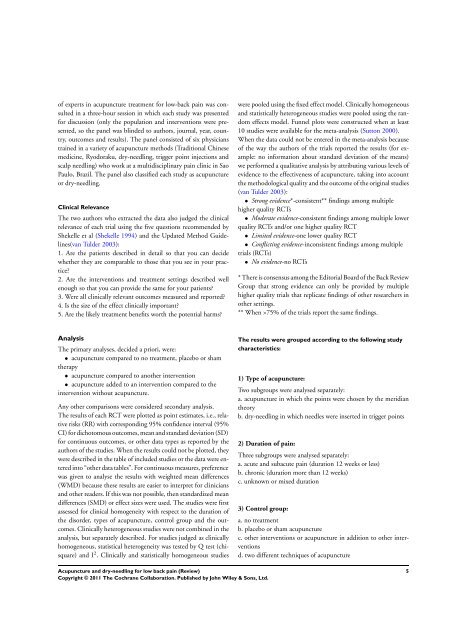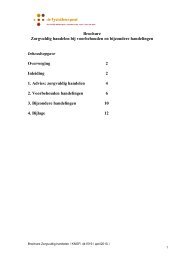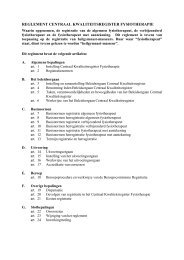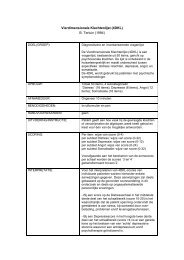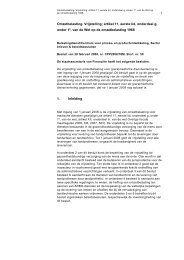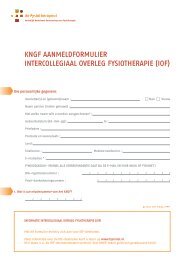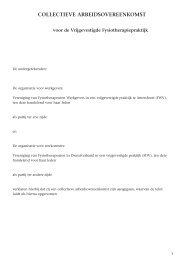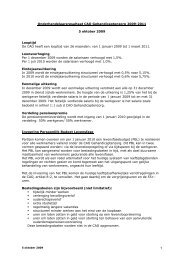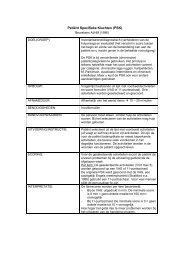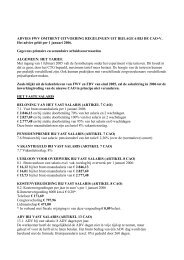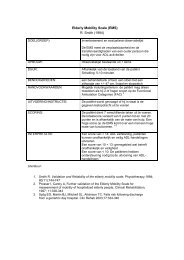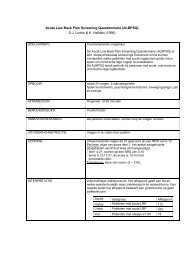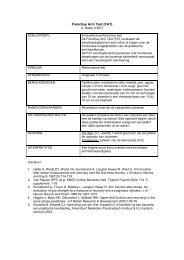Acupuncture and dry-needling for low back pain (Review)
Acupuncture and dry-needling for low back pain (Review)
Acupuncture and dry-needling for low back pain (Review)
You also want an ePaper? Increase the reach of your titles
YUMPU automatically turns print PDFs into web optimized ePapers that Google loves.
of experts in acupuncture treatment <strong>for</strong> <strong>low</strong>-<strong>back</strong> <strong>pain</strong> was consulted<br />
in a three-hour session in which each study was presented<br />
<strong>for</strong> discussion (only the population <strong>and</strong> interventions were presented,<br />
so the panel was blinded to authors, journal, year, country,<br />
outcomes <strong>and</strong> results). The panel consisted of six physicians<br />
trained in a variety of acupuncture methods (Traditional Chinese<br />
medicine, Ryodoraku, <strong>dry</strong>-<strong>needling</strong>, trigger point injections <strong>and</strong><br />
scalp <strong>needling</strong>) who work at a multidisciplinary <strong>pain</strong> clinic in Sao<br />
Paulo, Brazil. The panel also classified each study as acupuncture<br />
or <strong>dry</strong>-<strong>needling</strong>.<br />
Clinical Relevance<br />
The two authors who extracted the data also judged the clinical<br />
relevance of each trial using the five questions recommended by<br />
Shekelle et al (Shekelle 1994) <strong>and</strong> the Updated Method Guidelines(van<br />
Tulder 2003):<br />
1. Are the patients described in detail so that you can decide<br />
whether they are comparable to those that you see in your practice?<br />
2. Are the interventions <strong>and</strong> treatment settings described well<br />
enough so that you can provide the same <strong>for</strong> your patients?<br />
3. Were all clinically relevant outcomes measured <strong>and</strong> reported?<br />
4. Is the size of the effect clinically important?<br />
5. Are the likely treatment benefits worth the potential harms?<br />
were pooled using the fixed effect model. Clinically homogeneous<br />
<strong>and</strong> statistically heterogeneous studies were pooled using the r<strong>and</strong>om<br />
effects model. Funnel plots were constructed when at least<br />
10 studies were available <strong>for</strong> the meta-analysis (Sutton 2000).<br />
When the data could not be entered in the meta-analysis because<br />
of the way the authors of the trials reported the results (<strong>for</strong> example:<br />
no in<strong>for</strong>mation about st<strong>and</strong>ard deviation of the means)<br />
we per<strong>for</strong>med a qualitative analysis by attributing various levels of<br />
evidence to the effectiveness of acupuncture, taking into account<br />
the methodological quality <strong>and</strong> the outcome of the original studies<br />
(van Tulder 2003):<br />
• Strong evidence*-consistent** findings among multiple<br />
higher quality RCTs<br />
• Moderate evidence-consistent findings among multiple <strong>low</strong>er<br />
quality RCTs <strong>and</strong>/or one higher quality RCT<br />
• Limited evidence-one <strong>low</strong>er quality RCT<br />
• Conflicting evidence-inconsistent findings among multiple<br />
trials (RCTs)<br />
• No evidence-no RCTs<br />
* There is consensus among the Editorial Board of the Back <strong>Review</strong><br />
Group that strong evidence can only be provided by multiple<br />
higher quality trials that replicate findings of other researchers in<br />
other settings.<br />
** When >75% of the trials report the same findings.<br />
Analysis<br />
The primary analyses, decided a priori, were:<br />
• acupuncture compared to no treatment, placebo or sham<br />
therapy<br />
• acupuncture compared to another intervention<br />
• acupuncture added to an intervention compared to the<br />
intervention without acupuncture.<br />
Any other comparisons were considered secondary analysis.<br />
The results of each RCT were plotted as point estimates, i.e., relative<br />
risks (RR) with corresponding 95% confidence interval (95%<br />
CI) <strong>for</strong> dichotomous outcomes, mean <strong>and</strong> st<strong>and</strong>ard deviation (SD)<br />
<strong>for</strong> continuous outcomes, or other data types as reported by the<br />
authors of the studies. When the results could not be plotted, they<br />
were described in the table of included studies or the data were entered<br />
into “other data tables”. For continuous measures, preference<br />
was given to analyse the results with weighted mean differences<br />
(WMD) because these results are easier to interpret <strong>for</strong> clinicians<br />
<strong>and</strong> other readers. If this was not possible, then st<strong>and</strong>ardized mean<br />
differences (SMD) or effect sizes were used. The studies were first<br />
assessed <strong>for</strong> clinical homogeneity with respect to the duration of<br />
the disorder, types of acupuncture, control group <strong>and</strong> the outcomes.<br />
Clinically heterogeneous studies were not combined in the<br />
analysis, but separately described. For studies judged as clinically<br />
homogeneous, statistical heterogeneity was tested by Q test (chisquare)<br />
<strong>and</strong> I 2 . Clinically <strong>and</strong> statistically homogeneous studies<br />
The results were grouped according to the fol<strong>low</strong>ing study<br />
characteristics:<br />
1) Type of acupuncture:<br />
Two subgroups were analysed separately:<br />
a. acupuncture in which the points were chosen by the meridian<br />
theory<br />
b. <strong>dry</strong>-<strong>needling</strong> in which needles were inserted in trigger points<br />
2) Duration of <strong>pain</strong>:<br />
Three subgroups were analysed separately:<br />
a. acute <strong>and</strong> subacute <strong>pain</strong> (duration 12 weeks or less)<br />
b. chronic (duration more than 12 weeks)<br />
c. unknown or mixed duration<br />
3) Control group:<br />
a. no treatment<br />
b. placebo or sham acupuncture<br />
c. other interventions or acupuncture in addition to other interventions<br />
d. two different techniques of acupuncture<br />
<strong>Acupuncture</strong> <strong>and</strong> <strong>dry</strong>-<strong>needling</strong> <strong>for</strong> <strong>low</strong> <strong>back</strong> <strong>pain</strong> (<strong>Review</strong>)<br />
Copyright © 2011 The Cochrane Collaboration. Published by John Wiley & Sons, Ltd.<br />
5


